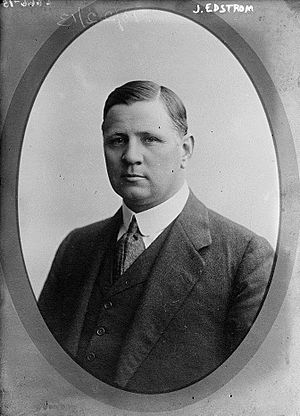Sigfrid Edström facts for kids
Quick facts for kids
Sigfrid Edström
|
|
|---|---|

Sigfrid Edström during the early 1910s
|
|
| 4th President of the International Olympic Committee | |
| In office 1942 – 15 August 1952 |
|
| Preceded by | Henri de Baillet-Latour |
| Succeeded by | Avery Brundage |
| Honorary President of the IOC | |
| In office 15 August 1952 – 18 March 1964 |
|
| Preceded by | vacant, last held by Pierre de Coubertin (1937) |
| Succeeded by | vacant, next held by Avery Brundage (1975) |
| Personal details | |
| Born | 11 November 1870 Morlanda, Sweden–Norway |
| Died | 18 March 1964 (aged 93) Stockholm, Sweden |
| Nationality | Swedish |
| Spouse | Ruth Randall Edström |
Johannes Sigfrid Edström (born November 11, 1870 – died March 18, 1964) was a Swedish businessman and important leader in sports. He became the fourth President of the International Olympic Committee (IOC).
Early Life and Career
Sigfrid Edström was born in a small village called Morlanda in Sweden. He was born on the island of Orust. He studied engineering at different universities. These included Chalmers University of Technology in Sweden, ETH Zürich in Switzerland, and schools in the United States.
When he was young, Edström was a very good sprinter. He could run 100 meters in just 11 seconds. After his studies, he worked as a director for the Gothenburg trams. He helped make them electric. From 1903 to 1939, he also led a big electrical company called ASEA.
Edström was very active in Swedish sports. He helped organize the 1912 Summer Olympics in Stockholm. During these Olympics, a new group was formed. It was called the International Amateur Athletics Federation (IAAF). Edström was chosen as its first president. He held this important job until 1946.
Leading the Olympic Movement
Edström joined the International Olympic Committee (IOC) in 1920. He became the vice-president in 1931. When the IOC president, Henri de Baillet-Latour, passed away in 1942, Edström became the acting president. This meant he took charge during World War II.
After the war ended, he was officially elected president. He worked hard to bring the Olympic Games back to life. He helped make sure the Olympics could continue after the war. In 1952, he stepped down from his role. Avery Brundage took over as president.
The Paavo Nurmi Controversy
In 1931, Edström was involved in a big decision. It was about a famous Finnish runner named Paavo Nurmi. Nurmi was a national hero in Finland. The IOC decided to stop Nurmi from competing in the 1932 Los Angeles Olympics. They said he was a professional athlete. This meant he had been paid to run, which was against the rules for amateur athletes at the time.
Many people, especially in Finland, were upset. They believed Nurmi was innocent. The decision caused some tension between Finland and Sweden. However, Nurmi got his moment of glory later. At the 1952 Summer Olympics in Helsinki, he carried the Olympic torch. He received a huge cheer from the crowd. Edström was there to see it.
Sigfrid Edström passed away in Stockholm on March 18, 1964.
See also
 In Spanish: Sigfrid Edström para niños
In Spanish: Sigfrid Edström para niños

